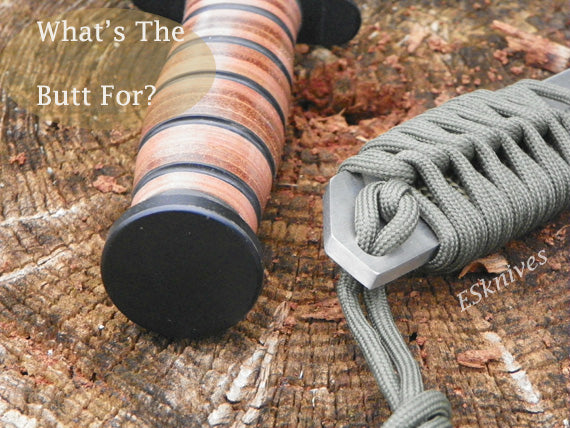How to Use the Butt of a Knife
When looking at knives most people concentrate on the blade. There are many blades, many jobs. Picking the right blade can take some time and research.
When buying a knife you might want to look at the other end. In a survival situation the handle and the butt can be as important as the blade. Having a solid metal butt or a full tang extension is the way to go. The primary reason you want a solid metal butt or a tang extension beyond the end of the handle material is so you can hammer on the end of the knife. A metal butt gives you the ability to drive your knife into something without damaging the handle. This works great when working with larger pieces of wood and turning them into smaller pieces of wood, know as batoning. You can use your knife to split wood. Stick your knife in your log and hit the end with something like another log or a rock and now you have split the wood.
A hammer is a vital survival tool. A solid flat or extended pommel can also be used as an improvised hammer. When you are in a survival situation or in the woods a hammer comes in handy. The pommel is easier to use than a rock or a piece of wood. If you are camping and setting up a tent the pommel works great pounding in those stakes.

When looking at handles you want to have a full or half cross hilt. A good hilt will prevent accidental cuts if your hand slips. You don't want a serious cut when medical attention is unavailable. A half guard gives better control of the blade when precision is called for. Some knives have a small portion of the top back end of the blade notched with grooves or ridges that creates a non-slip spot to put your thumb or a finger on when needed for those types of jobs.
Looking at a handle with a lanyard hole is important. A lanyard prevents the loss of your knife. You don't want to accidentally lose the most valuable survival tool you have. When using your knife always use a wrist lanyard especially, when working over water or long drops. You'll want a cinch on your strap to tighten it to the wrist. A simple loop can simply slip off your wrist.
If you can try out the handle before you buy. You want the handle to be comfortable in any position. The best handles provide a firm grip. When the handle is wet you want it to be slip-resistant. Be wary of handles that are too grippy or made from aggressive materials because they can cause hot spots and blisters when heavily used. This is why skeletonized handles are usually wrapped with parachute cord.
When buying a knife the blade is not the only thing to consider. Spend some time on the handle. You will be happy you did.
Related Posts
-
Weekly Knife Giveaway - Claim your Entry
We're giving away a knife every week through the end of A...
-
Survival with Bandanas
When I am out in the wild for more than a day I always th...








Comments